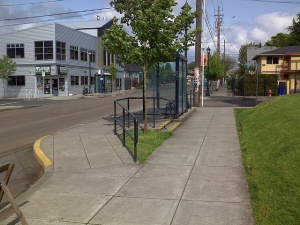Difference between revisions of "Out-of-vehicle experience"
Jump to navigation
Jump to search
| Line 1: | Line 1: | ||
| − | == | + | ==Introduction== |
| + | |||
| + | [[File:Portland Bus Stop.jpg|thumb|right|300px|This bus stop in Portland, Ore., provides amenities like shelter. Photo by Flickr user Jason McHuff.]] | ||
| + | |||
| + | |||
Certain low cost strategies, such as real-time arrival and routing information, attractive waiting areas, universal fare media, marketing/perception influence, and other low-cost measures can cost-effectively increase ridership by improving the transit experience. | Certain low cost strategies, such as real-time arrival and routing information, attractive waiting areas, universal fare media, marketing/perception influence, and other low-cost measures can cost-effectively increase ridership by improving the transit experience. | ||
Revision as of 00:11, 8 March 2012
Introduction
Certain low cost strategies, such as real-time arrival and routing information, attractive waiting areas, universal fare media, marketing/perception influence, and other low-cost measures can cost-effectively increase ridership by improving the transit experience.
The out-of-vehicle waiting experience plays a critical role in an individual’s willingness to use transit for their traveling needs. A pleasant walk to and wait at a transit stop can add value to the transit experience, while time spent in a dirty, loud or unsafe environment is perceived to be much more costly that time spent in-vehicle.
- Further reading: Victoria Transport Policy Institute. "Valuing Transit Service Quality Improvements." 2008.
Strategies
Real-time arrival and routing information
- Reduces anxiety about when the next bus will come
- Allows more accurate trip planning, so less time has to be spent at the actual stop
- Further Reading: National Center for Transit Research at the Center for Urban Transportation Research, University of South Florida. “Enhancing the Rider Experience: The Impact of Real-Time Information On Transit Ridership.” 2005.
Attractive and more secure waiting areas
- Studies suggest that time spent waiting for a transit vehicle is considered more costly by the patron than in-vehicle time; however, this can be mitigated by improvements to the waiting area, i.e. good lighting, protection from the elements and a comfortable place to sit.
- Further Reading: Institute of Transportation Studies University of California, Berkeley. "The Effects of Out-of-Vehicle Time on Travel Behavior." 2006.
Improvement to the quality of pedestrian network
- Virtually all transit riders are pedestrians at some point in their trip. So the quality of the pedestrian network -- principally sidewalks and safe road crossings -- strongly influences the ability of travelers to access transit stops and then their willingness to use transit. Factors include the very existence of sidewalks, their connectivity in a useful network, and whether or not residents feel safe using them.
- Further Reading: Sherry Ryan and Lawrence Frank. "Pedestrian Environments and Transit Ridership." 2009.
- Further Reading: Portland State University Center for Urban Studies. “Pedestrian Infrastructure Improvements: Effects on Transit Use and Perceptions of the Pedestrian Environment In Portland’s Roseway Neighborhood.“ 1999.
